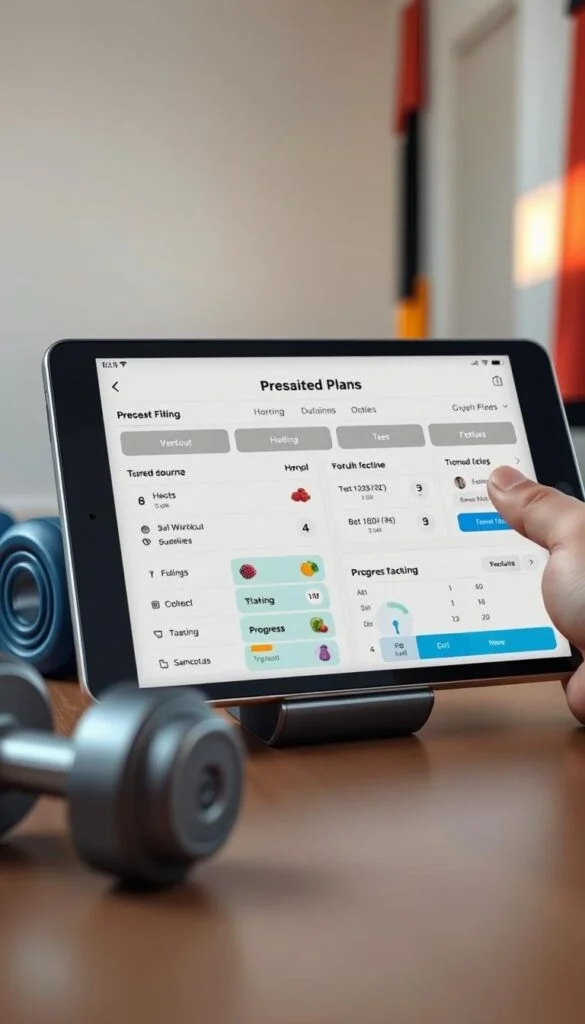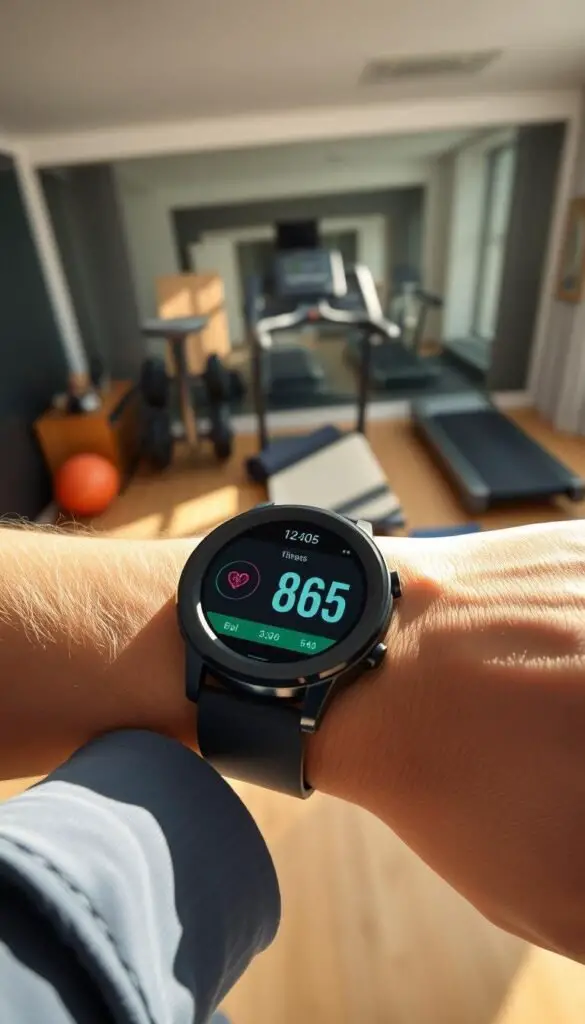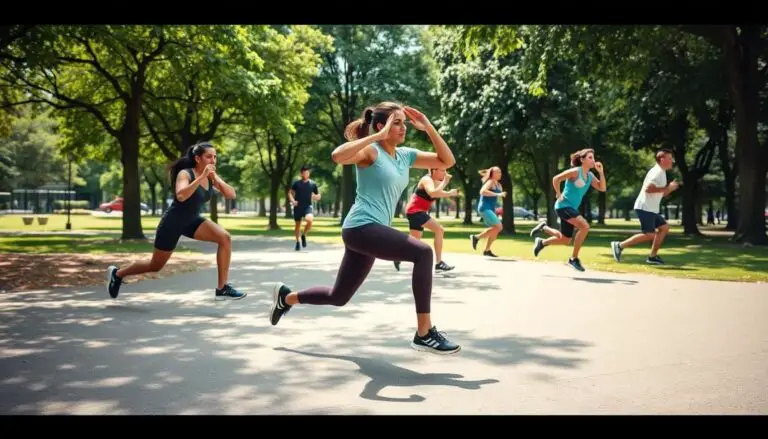(Hey! Some links in this post may be affiliate links — meaning I may earn a small commission if you buy through them, at no extra cost to you. As an Amazon Associate, I earn from qualifying purchases. I only share products I genuinely love and think you’ll find useful too. Read the full disclosure here).
Setting realistic fitness goals is key to a successful fitness journey. It’s not just about reaching the end goal. It’s about enjoying the journey too. By setting goals that are realistic, you stay motivated and can actually reach them.
Realistic fitness goals help you create a clear path to success. By setting smaller, achievable targets, you make progress easier to see. This builds your confidence and helps you reach your fitness goals.
Contents
- 1 Understanding the Importance of Realistic Fitness Goals
- 2 Assessing Your Current Fitness Level
- 3 Defining Your Fitness Vision
- 4 Setting SMART Fitness Goals
- 5 Identifying Potential Challenges
- 6 Creating a Personalized Fitness Plan
- 7 Staying Motivated on Your Fitness Journey
- 8 Adjusting Goals as You Progress
- 9 Utilizing Technology for Fitness Tracking
- 10 Nutrition’s Role in Achieving Fitness Goals
- 11 Getting Support from Professionals
- 12 Evaluating Your Progress Periodically
Understanding the Importance of Realistic Fitness Goals
Reaching fitness success starts with setting realistic goals. Many people aim too high and feel let down when they can’t reach it. Attainable health objectives help by setting goals that are both challenging and reachable.
It’s important to know what works for you. Some think the only way to succeed is to push yourself too hard. But this can lead to burnout. Instead, aiming for manageable workout aspirations helps you make steady progress and stay motivated.

There are myths about needing extreme exercise to succeed. But this can harm your health. By focusing on attainable health objectives and manageable workout aspirations, you can stay healthy and fit for the long term.
Realistic fitness goals offer many benefits. They include:
- Increased motivation and confidence
- Improved overall health and well-being
- Reduced risk of injury or burnout
By understanding the value of realistic fitness goals, you can set yourself up for success. Focus on attainable health objectives and manageable workout aspirations to reach your fitness goals.
Assessing Your Current Fitness Level
To set reachable fitness milestones, knowing your current fitness is key. You need to check your body fat, muscle mass, and heart health. This helps you set practical physical fitness goals that fit your needs and abilities.
There are many ways to check your fitness level. You can use:
- Body measurements, such as waist circumference and body mass index (BMI)
- Fitness tests, like the 1-mile run or push-up test
- Cardiovascular assessments, such as heart rate monitoring
These tools help you understand your fitness strengths and weaknesses. For beginners, walking for 30 minutes a day might be a goal. For more experienced people, running a marathon could be the target. The goal is to set practical physical fitness goals that are both challenging and reachable, helping you hit your reachable fitness milestones.

Remember, checking your fitness level is an ongoing task. As you reach new reachable fitness milestones, you’ll need to update your goals. This way, you can keep pushing yourself and moving closer to your practical physical fitness goals.
Defining Your Fitness Vision
Setting clear goals is key to reaching your gym targets. You need to aim for health and wellness goals that are specific, measurable, and achievable. This will guide you and keep you motivated on your fitness path.
First, think about what you want to achieve now and in the future. Ask yourself, “What do I want to do in the next few months?” and “What are my goals for the next year?” This helps you set smaller goals that lead to bigger ones.
Short-term vs. Long-term Goals
- Set specific, achievable goals for the next few months, such as increasing your daily step count or completing a certain number of workouts per week.
- Create a long-term vision for your fitness journey, including goals like running a marathon or completing a challenging workout program.
Creating a fitness vision board can be a powerful tool. Cut out images and words that represent your goals. Arrange them in a way that inspires you. This keeps you focused on your health and wellness goals and reminds you of your aspirations.

Creating a Fitness Vision Board
Remember, setting your fitness vision is a personal and ongoing journey. Be patient, stay positive, and celebrate your small victories. This way, you can create a realistic and achievable plan for your health and wellness goals.
Setting SMART Fitness Goals
To succeed in fitness, setting realistic goals is key. It’s important to aim for achievable exercise targets. Think about what you want to achieve and how you can get there. This means setting specific, measurable, achievable, and time-bound goals.
Setting realistic fitness goals keeps you focused and motivated. It’s about having a clear plan and tracking your progress. By aiming for achievable targets, you avoid getting frustrated and stay on track.
- Defining clear objectives that align with your fitness vision
- Tracking progress to measure success
- Setting realistic expectations that are achievable and challenging
- Creating a timeline to stay on track and motivated
By using these elements, you can make a solid fitness plan. This plan will help you reach your realistic fitness goals and set achievable exercise targets.
Identifying Potential Challenges
Starting your fitness journey means you’ll face obstacles. Knowing these challenges helps you find ways to beat them. One big hurdle is lack of motivation. To overcome this, try working out with a friend or joining a fitness group for support.
Physical limits can also block your path. If you’re new to exercise or have health issues, talk to a doctor first. They can help you make a fitness plan that’s right for you. This way, you can avoid injuries and keep moving towards your goals.

- Creating a contingency plan for unexpected setbacks
- Setting realistic expectations and celebrating small victories
- Seeking guidance from a fitness professional or mentor
Using these strategies will help you tackle challenges and reach your fitness goals. Remember, success in fitness comes from being patient, persistent, and flexible. Always be ready to adjust your plan as needed.
Creating a Personalized Fitness Plan
To reach practical physical fitness goals, making a personalized fitness plan is key. It should match your lifestyle and daily routine. This way, it’s both challenging and doable. Setting reachable fitness milestones helps you track progress and stay motivated.
A good plan includes a mix of workouts to prevent boredom and injuries. You can add cardio, strength training, and flexibility exercises. Here are some examples:
- Brisk walking or jogging
- Swimming or cycling
- Yoga or Pilates
- Weightlifting or bodyweight exercises
Adding variety keeps your workouts interesting and effective. Setting reachable fitness milestones also keeps you focused and motivated. This way, you can reach your practical physical fitness goals in a fun and lasting way.

Staying Motivated on Your Fitness Journey
Reaching your fitness goals needs more than a good plan. It takes motivation and support. As you move forward, finding ways to stay motivated is key. This is true even when you hit bumps or setbacks.
Finding a fitness community is a great way to stay motivated. This could be an online group, a local gym, or friends who share your fitness goals. Being part of a community lets you connect with others, learn from them, and get support.

Also, celebrating small victories is important. Recognizing your progress helps you keep going. You might treat yourself to a new workout outfit or share your success with loved ones. Focusing on achievable goals helps you feel proud and motivated.
Strategies for Staying Motivated
- Set achievable milestones and reward yourself when you reach them
- Find a workout buddy or join a fitness group to stay accountable and motivated
- Track your progress and celebrate small wins along the way
Using these strategies can help you stay on track, even when things get tough. Remember, reaching your fitness goals is a journey. Staying motivated is essential for success.
Adjusting Goals as You Progress
As you keep moving forward in your fitness journey, you might find that your goals need to change. This is a normal part of the journey. Flexibility is key to success. By setting realistic fitness goals and setting achievable exercise targets, you can stay on track.
There are many reasons why you might need to adjust your goals. Maybe your schedule has changed, you’ve gotten injured, or your priorities have shifted. It’s important to know when it’s time to change and have a plan for how to do it.
Recognizing When to Modify Goals
So, how do you know when it’s time to change your goals? Look out for these signs:
- You’ve hit a plateau and aren’t making progress anymore.
- Your schedule or priorities have changed, making it hard to reach your original goal.
- You’ve gotten injured or sick and can’t keep up with your original plan.

The Importance of Flexibility
Being able to adjust your goals as you go is key to success in fitness. By being flexible and open to change, you can keep working towards goals that are both challenging and achievable. This way, you’re always setting targets that match your current abilities and dreams.
Utilizing Technology for Fitness Tracking
Technology has changed how we work out, making it simpler to reach attainable health objectives. Fitness apps and devices help us track our progress and understand our health better. They let us set manageable workout aspirations, making our fitness journey more realistic and achievable.
There are many fitness apps and devices out there. Some track your daily activity, like steps and calories burned. Others focus on specific workouts, like running or strength training. These tools show us how far we’ve come, keeping us motivated and focused on our goals.

Social media also helps with goal setting, providing a sense of community and accountability. We can share our progress, connect with others, and join fitness challenges. This helps us stay on track and reach our attainable health objectives. By using technology and social media, we can build a supportive environment for our fitness goals.
Using technology for fitness tracking has many benefits:
- It boosts motivation and accountability.
- It improves tracking and monitoring of progress.
- It helps in setting and achieving goals.
- It gives access to a supportive community and resources.
Nutrition’s Role in Achieving Fitness Goals
To hit reachable fitness milestones, you need both regular exercise and a balanced diet. A good diet gives your body the fuel it needs for workouts and helps with recovery. Nutrition is key in supporting your body’s needs for practical physical fitness goals.
It’s important to know how to balance diet and exercise for success. You need to eat the right foods to boost energy and help muscles grow. Without the right nutrients, reaching reachable fitness milestones can be tough.

- Eating a variety of whole foods, including fruits, vegetables, whole grains, and lean proteins
- Staying hydrated by drinking plenty of water
- Avoiding processed and high-sugar foods that can hinder progress
By focusing on practical physical fitness goals and eating well, you can set yourself up for success. This way, you can reach your desired outcomes.
Getting Support from Professionals
Getting support from professionals can change the game when aiming for health and wellness goals. A team of experts can offer the guidance and motivation you need. Whether you’re starting out or looking to advance, their support can keep you on track.
Hiring a personal trainer is a big step. They create workout plans that fit your level, goals, and any limitations. They also teach you the right form and technique, making your workouts safer and more effective.
Benefits of Professional Guidance
- Personalized workout plans tailored to your needs and goals
- Expert guidance on proper form and technique
- Ongoing motivation and support to help you stay on track
Consulting a nutritionist is also very helpful. They give you dietary advice that fuels your body for top performance. This way, you can balance your fitness goals with a healthy lifestyle.
Evaluating Your Progress Periodically
Starting your fitness journey means you need to check your progress often. This helps you stay on track with your goals and keep your exercise targets realistic. Checking in regularly, like weekly or monthly, helps you see how far you’ve come and what you need to work on.
Looking back at your fitness journey is important. It lets you celebrate your wins and find areas to get better. This helps you stay motivated and makes sure your goals are right for you.
Your fitness journey changes over time, and being flexible is key. By regularly checking your progress and making changes, you’ll keep moving forward. This way, you’ll reach your goals and enjoy a healthier, more active life.






